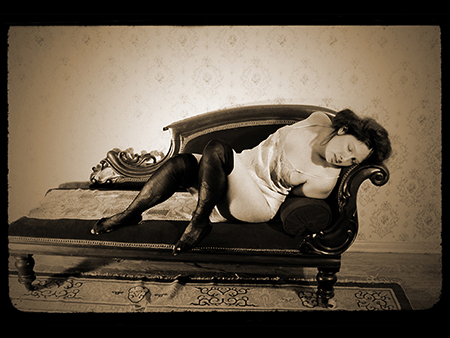
Continuing through February 17, 2024
Although Nancy Youdelman is recognized for her sculptural assemblages based on women’s clothing and accessories, this exhibition focuses mostly on a lesser-known aspect of her oeuvre — performative photography from 1971 to ’75 that was produced right after having participated in the Feminist Art Program led by Judy Chicago at California State University, Fresno and by Chicago and Miriam Schapiro at the California Institute of the Arts.
As a student in this all-female program, Youdelman and her classmates would dress up in costumes and role-play as a means of exploring female identity. At the time, women artists were usually treated like second class citizens in the art world. The endeavors of the students and their mentors gave birth to the groundbreaking, politically motivated 1972 exhibition “Womanhouse.” For that project, Youdelman created a collaborative installation of a predominantly pink parlor room filled with lacy fabrics, perfume bottles, and other feminine fashion items. Youdelman and her collaborators also performed in the space, telling real stories about the abuse and mistreatment of women.
Involvement with costuming and storytelling also led Youdelman to create a significant body of photographic work. In 1971, she was working on a film in which she performs as a woman resuscitated from the dead. Although she used funerary wreaths taken at night from a cemetery as props, she found that she was mostly intrigued with the ragged wig, heavy eye makeup, and frilly garment that she wore as elements of what she viewed as conceptual self-portraiture. Opting to emphasize physical appearance and expressions over staging or choreography, she produced “Films Stills Death” (1971-2021) as photographic prints, but never completed the film. (It is worth noting that this project began six years before Cindy Sherman exhibited her legendary “Film Stills,” in which Sherman presents herself as various female stereotypes popularized by movies.)
Youdelman’s fascination with death stems in part from having lost her father to cancer when she was nine years old. Subsequently she picnicked frequently at a cemetery with her mother. It is also related to her love of Edgar Allan Poe’s writings, which include visions of people being buried alive, a scenario that Youdelman acted out in “Shallow Grave,” (1973), a sequence of six color photographs of her being buried in a shallow grave dug in her backyard. While the project took place the same year that New York-based Ana Mendieta also photographed herself buried in the earth, Mendieta’s “Silueta” series concerns the feminine connection to nature.
In 1974, Youdelman continued to explore different female personas, now by transporting herself to earlier eras as in “Self Portrait, 1890,” a diptych where she is shown with vintage hairdo and clothing in homemade period style frames. In the “After Bellocq (Self Portrait of the Artist)” series she impersonates a prostitute posing on a couch in the manner of E.J. Bellocq’s early 20th century photographs of the New Orleans Storyville hookers.
In “The Gift” (1974), Youdelman reenacts a dream where she gazes into an antique mirror after being told she can travel through it to the past. In the black-and-white photos, she simulates the act of pushing her finger through the mirror and then pulling it out to reveal that her finger has turned black. In sequences from the hand-tinted color photos that comprise “Dream Series” (1975), she acts out a number of different narratives, such as entering an abandoned house to discover a purse left behind by a woman who had died, and assuming the persona of a woman who looks into a mirror and realizes she has become old. She then comes across a pink dress from her youth and hangs it up because she can no longer wear it. Sporting a blonde wig in this example, Youdelman bears an uncanny resemblance to Bay Area artist Lynn Hershman Leeson’s fictional alter-ego Roberta Breitman, developed during the same period.
Working independently of Sherman, Mendieta, and Hershman Leeson, Youdelman was clearly on the same wavelength as these other pioneering explorers of female identity. While her early ventures into performative photography clearly established her place in the feminist art history of the 1970s, they also paved the way for her unique mature vision, a point beautifully made in the exhibition’s inclusion of four dress assemblages from the past decade. In Youdelman’s signature sculptures, clothing has moved from being merely a prop to occupying the role of primary subject. Using a process that begins with a plaster and acrylic mold from actual clothing, the artist embellishes each casting with sumptuous surfaces made from buttons, broken glass, jewels, dried flowers, and other assorted bric-a-brac. Exquisite in execution and presentation, each dress sculpture functions as an emblematic homage to fashion and the idea that “clothes make the man” (or woman). The dresses on view celebrate elegance (“Evening”; 2014), strength and endurance (“Flower Power”; 2014), legacy (“Relic; 2014), and death (“Ophelia”; 2014). With the last topic, Youdelman returns to her origins full circle.
